
©2024 League of Conservation Voters
The Alaska Center and Native Peoples Action host community art activation in Southeast D.C. at Diamond Teague Park with Alaska Native activist Sophie Swope
Washington, D.C. — In case you missed it, over the weekend, The Alaska Center, Alaska state affiliate of the League of Conservation Voters (LCV), Native Peoples Action, and Alaska based Indigenous activist Sophie Swope unveiled a new video projected on a 9,000 pound ice sculpture of a salmon jumping out of water in front of Earth Conservation Corps’ Monique Johnson Anacostia River Center. The event, which took place in advance of Indigenous Peoples Day, is a message to Congress to share how Indigenous Alaskans are impacted by climate injustice and how the richness of Indigenous knowledge can help lead our path forward. The climate crisis needs federal action now and that means investing and building infrastructure that works for and with traditional ways of life. The installation featured testimony from Alaska Native peoples facing the calamitous economic, health, and communal impacts of climate change through short films captured by Alaskan videographer Chris Ho. See photos from the event HERE.
WATCH: “Inextricably linked to this land: Our Home. Our future. Our Alaska”
“Climate change is challenging the traditional ways of life and hurting my community. The numbers of fish in our rivers — specifically salmon — are declining, and hunting and harvesting trails are not freezing properly,” said activist Sophie Swope, of Cup’ik descent from Mamterilleq Bethel, Alaska. “We can’t keep compromising our climate and polluting our waters, lands, and community health…Let’s listen to those most impacted by the climate crisis and pollution who have for too long, not had a seat at the table. There is a world of opportunity here now, we just need our leaders to take bold steps forward and pass legislation that will support our future and address environmental injustice.”
“For too long, extractive industries have polluted our communities, our climate and our economic health in Alaska,” said Leah Moss, Communications Director for The Alaska Center. “It’s time that our leaders invest in the long term health of Alaskans and invest in the vibrant future that clean energy jobs and a commitment to climate justice could make possible. We are at a pivotal moment to Build Back Better and we must act now before climate change destroys more communities in our state. We need policy makers to take bold action on climate that helps Alaskans thrive, not just survive.”
“Indigenous peoples have stewarded the lands and waters across this nation since time immemorial. Having our voices at the decision-making tables with projects that directly impact our ways of life is imperative,” stated Kendra Kloster, Executive Director, Native People’s Action. “There is vast opportunity and potential for economic growth in our Tribal communities and regions when our Indigenous voices are part of the processes that affect our people, lands, waters and all relations. Our ways of life are on the line – the time is now for investments toward climate justice solutions in partnership with Indigenous people.”
Andrea Wuya states in the video, “Some of these things are irreversible, and to see that the number of our salmon population decrease due to climate change is scary because you think of the generations after us, and how are they going to sustain themselves out here?”
With the latest Intergovernmental Panel on Climate (IPCC) report citing a “code red for humanity,” communities are mobilizing to demand action at the scale that science and justice demand. Alaskans, especially Indigenous communities, know all too well the extreme effects of climate change. From melting glaciers and the loss of salmon which is a major food source and livelihood for many to loss of jobs and opportunities for generations of young people as extractive industries leave Alaskans behind. Alaskans know the urgency to shift the economy from an extractive one to a renewable one and Alaskans see themselves as a space of opportunity for investment in a cleaner more sustainable economy. This art activation sends a clear message to Washington, DC from Alaskans that it’s time to listen to Indigenous peoples and knowledge that have stewarded this land since time immemorial. It’s time to invest in communities so that they can continue their way of life today and so that future generations can thrive for years to come. It is very much time to go big on climate.
This installation is just another way people are coming together across the country to call for bold climate infrastructure investments that deliver clean energy, jobs and justice. Artists have lent their talents for similar art activations across the country, including in Reno, Nevada and St. Paul, Minnesota.
###